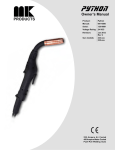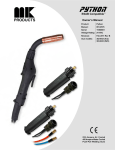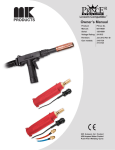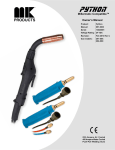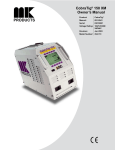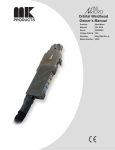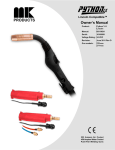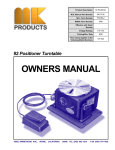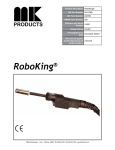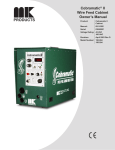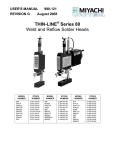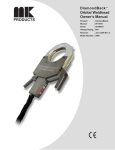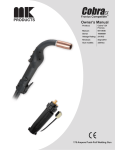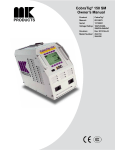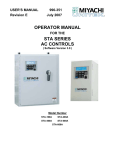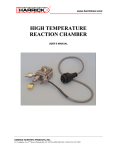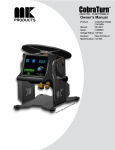Download OWNER`S MANUAL
Transcript
Product Description CobraCooler® MK Manual Part Number MK Form Number NWSA Form Number 091-0542 CBRCLR/OM 550 Effective with Serial Number 03010007 Voltage Rating 100/120/208/240VAC Printing Date & Revision January 2003 This manual applies to the 250-151 following model numbers CobraCooler® OWNER’S MANUAL 16882 ARMSTRONG AVE., IRVINE, CA 92606 TEL (949)863-1234 FAX (949)474-1428 SAFETY CONSIDERATIONS ELECTRIC ARC WELDING EQUIPMENT CAUTION : READ BEFORE ATTEMPTING INSTALLATION, OPERATION OR MAINTENANCE OF THIS EQUIPMENT 1-1 INTRODUCTION This equipment is intended for ultimate application by commercial/industrial users and for operation by persons trained and experienced in the use and maintenance of welding equipment. Operation should not be undertaken without adequate training in the use of such equipment. Training is available from many public and private schools or similar facilities. Safe practices in the installation, operation and maintenance of this equipment requires proper training in the art, a careful study of the information provided with the equipment, and the use of common sense. Rules for safe use are generally provided by suppliers of welding power sources, compressed gas suppliers, and electrode suppliers. Careful compliance with these rules will promote safe use of this equipment. The following Safety Rules cover some of the more generally found situations. READ THEM CAREFULLY. In case of any doubt, obtain qualified help before proceeding. 1-2 GENERAL PRECAUTIONS A. Burn Prevention ELECTRIC ARC WELDING PRODUCES HIGH INTENSITY HEAT AND ULTRAVIOLET RADIANT ENERGY WHICH MAY CAUSE SERIOUS AND PERMANENT EYE DAMAGE AND WHICH MAY DAMAGE ANY EXPOSED SKIN AREAS. Wear helmet with safety goggles or glasses with side shields underneath, appropriate filter lenses or plates (protected by clear cover glass). This is a must for welding or cutting (and chipping) to protect the eyes from radiant energy and flying metal. Replace cover glass when broken, pitted, or spattered. Medical first aid and eye treatment. First aid facilities and a qualified first aid person should be available for each shift unless medical facilities are close by for immediate treatment of flash burns of the eyes and skin burns. Wear protective clothing - leather (or asbestos) gauntlet gloves, hat, and high safety-toe shoes. Button shirt collar and pocket flaps, and wear cuffless trousers to avoid entry of sparks and slag. Avoid oily or greasy clothing. A spark may ignite them. Flammable hair preparations should not be used by persons intending to weld or cut. Hot metal such as electrode stubs and work pieces should never be handled without gloves. Ear plugs should be worn when working on overhead or in a confined space. A hard hat should be worn when others work overhead. B. Toxic Fume Prevention WARNING: The use of this product may result in exposure to chemicals known to the State of California to cause cancer and birth defects or other reproductive harm. Adequate ventilation. Severe discomfort, illness or death can result from fumes, vapors, heat, or oxygen enrichment or depletion that welding (or cutting) may produce. Prevent them with adequate ventilation. NEVER ventilate with oxygen. Lead-, cadmium-, zinc-, mercury-, beryllium-bearing and similar materials, when welded or cut, may produce harmful concentrations of toxic fumes. Adequate local exhaust ventilation must be used, or each person in the area, as well as the operator, must wear an air-supplied respirator. For beryllium, both must be used. Metals coated with or containing materials that emit toxic fumes should not be heated unless coating is removed form the work surface, the area is well ventilated, or the operator wears an air-supplied respirator. Work in a confined space only while it is being ventilated and, if necessary, while wearing an air-supplied respirator. Causes of fire and explosion are: combustibles reached by the arc, flame, flying sparks, hot slag, or heated material, misuse of compressed gases and cylinders, and short circuits. BE AWARE THAT flying sparks or falling slag can pass through cracks, along pipes, through windows or doors, and through wall or floor openings, out of sight of the goggled operator. Sparks can fly many feet. To prevent fires and explosion: Keep equipment clean and operable, free of oil, grease, and (in electrical parts) of metallic particles that can cause short circuits. If combustibles are in area, do NOT weld or cut. Move the work if practicable, to an area free of combustibles. Avoid paint spray rooms, dip tanks, storage areas, ventilators. If the work cannot be moved, move combustibles at least 35 feet away, out of reach of sparks and heat; or protect against ignition with suitable and snug-fitting, fire-resistant covers or shields. Walls touching combustibles on opposite sides should not be welded on (or cut). Walls, ceilings, and floor near work should be protected by heat-resistant covers or shields. Fire watcher must be standing by with suitable fire extinguishing equipment during and for some time after welding or cutting if: Gas leaks in a confined space should be avoided. Leaked gas in large quantities can change oxygen concentration dangerously. Do not bring gas cylinders into a confined space. 1. Appreciable combustibles (including building construction) are within 35 feet. Leaving confined space, shut OFF gas supply at source to prevent possible accumulation of gases in the space if downstream valves have been accidentally opened or left open. Check to be sure that the space is safe before reentering it. 3. Openings (concealed or visible) in floors or walls within 35 feet may expose combustibles to sparks. Vapors from chlorinated solvents can be decomposed by the heat of the arc (or flame) to form PHOSGENE, a highly toxic gas, and other lung and eye irritating products. The ultraviolet (radiant) energy of the arc can also decompose trichloroethylene and perchloroethylene vapors to form phosgene. DO NOT WELD or cut where solvent vapors can be drawn into the welding or cutting atmosphere or where the radiant energy can penetrate to atmospheres containing even minute amounts of trichloroethylene or perchloroethylene. C. Fire and Explosion Prevention 2. Appreciable combustibles are further than 35 feet, but can be ignited by sparks. 4. Combustibles adjacent to walls, ceilings, roofs, or metal partitions can be ignited by radiant or conducted heat. Hot work permit should be obtained before operation to ensure supervisor’s approval that adequate precautions have been taken. After work is done, check that area is free of sparks, glowing embers, and flames. An empty container that held combustibles, or that can produce flammable or toxic vapors when heated, must never be welded on or cut, unless container has first been cleaned in accordance with industry standards. This includes: a thorough steam or caustic cleaning (or a solvent of water washing, depending on the combustible’s solubility), followed by purging and inerting with nitrogen or carbon dioxide, and using protective equipment. NEVER DEFACE or alter name, number, or other markings on a cylinder. It is illegal and hazardous. Water-filling just below working level may substitute for inerting. Prohibited use. Never use a cylinder or its contents for other than its intended use, NEVER as a support or roller. A container with unknown contents should be cleaned (see paragraph above). Do NOT depend on sense of smell or sight to determine if it is safe to weld or cut. Hollow castings or containers must be vented before welding or cutting. They can explode. Explosive atmospheres. NEVER weld or cut where the air may contain flammable dust, gas, or liquid vapors (such as gasoline). D. Compressed Gas Equipment The safe handling of compressed gas equipment is detailed in numerous industry publications. The following general rules cover many of the most common situations. 1. Pressure Regulators Regulator relief valve is designed to protect only the regulator from overpressure; it is not intended to protect any downstream equipment. Provide such protection with one or more relief devices. Never connect a regulator to a cylinder containing gas other than that for which the regulator was designed. Remove faulty regulator from service immediately for repair (first close cylinder valve). The following symptoms indicate a faulty regulator: Leaks - if gas leaks externally. Excessive Creep - if delivery pressure continues to rise with downstream valve closed. Faulty Gauge - if gauge pointer does not move off stop pin when pressurized, nor returns to stop pin after pressure release. Empties: Keep valves closed, replace caps securely; mark MT; keep them separate from FULLS, and return promptly. Locate or secure cylinders so they cannot be knocked over. Passageways and work areas. Keep cylinders clear of areas where they may be stuck. Transporting cylinders. With a crane, use a secure support such as a platform or cradle. Do NOT lift cylinders off the ground by their valves or caps, or by chains, slings, or magnets. Do NOT expose cylinders to excessive heat, sparks, slag, and flame, etc. that may cause rupture. Do not allow contents to exceed 55 degrees C (130 degrees F.) Cool with water spray where such exposure exists. Protect cylinders, particularly valves from bumps, falls, falling objects, and weather. Replace caps securely when moving cylinders. Stuck valve. Do NOT use a hammer or wrench to open a cylinder valve that cannot be opened by hand. Notify your supplier. Mixing gases. NEVER try to mix any gases in a cylinder. NEVER refill any cylinder. Cylinder fittings should never be modified or exchanged. 3. Hose Prohibited use. Never use hose other than that designed for the specified gas. A general hose identification rule is: red for fuel gas, green for oxygen, and black for inert gases. Use ferrules or clamps designed for the hose (not ordinary wire or other substitute) as a binding to connect hoses to fittings. No copper tubing splices. Use only standard brass fittings to splice hose. Wipe with a clean, lintless cloth. Match regulator to cylinder. Before connecting, check that the regulator label and cylinder marking agree, and that the regulator inlet and cylinder outlet match. NEVER Connect a regulator designed for a particular gas or gases to a cylinder containing any other gas. Tighten connections. When assembling threaded connections, clean and smooth seats where necessary. Tighten. If connection leaks, disassemble, clean, and retighten, using properly fitting wrench. Adapters. Use a CGA adapter (available from your supplier) between cylinder and regulator, if one is required. Use two wrenches to tighten adapter marked RIGHT and LEFT HAND threads. Regulator outlet (or hose) connections may be identified by right hand threads for oxygen and left hand threads (with grooved hex on nut or shank) for fuel gas. 5. Pressurizing Steps: Drain regulator of residual gas through suitable vent before opening cylinder (or manifold valve) by turning adjusting screw in (clockwise). Draining prevents excessive compression heat at high pressure seat by allowing seat to open on pressurization. Leave adjusting screw engaged slightly on single-stage regulators. Stand to side of regulator while opening cylinder valve. Open cylinder valve slowly so that regulator pressure increases slowly. When gauge is pressurized (gauge reaches regulator maximum) leave cylinder valve in following position: for oxygen and inert gases, open fully to seal stem against possible leak; for fuel gas, open to less than one turn to permit quick emergency shut-off. Use pressure charts (available from your supplier) for safe and efficient recommended pressure settings on regulators. Avoid long runs to prevent kinks and abuse. Suspend hose off ground to keep it from being run over, stepped on, or otherwise damaged. Check for leaks on first pressurization and regularly thereafter. Brush with soap solution. Bubbles indicate leaks. Clean off soapy water after test; dried soap is combustible. 2. Cylinders Cylinders must be handled carefully to prevent leaks and damage to their walls, valves, or safety devices: Coil excess hose to prevent kinks and tangles. E. User Responsibilities Protect hose from damage by sharp edges, and by sparks, slag, and open flame. Avoid electrical circuit contact with cylinders including third rails, electrical wires, or welding circuits. They can produced short circuit arcs that may lead to a serious accident. (See 1-3C) Examine hose regularly for leaks, wear, and loose connections. Immerse pressured hose in water; bubbles indicate leaks Remove leaky or defective equipment from service immediately for repair. Read and follow user manual instructions. ICC or DOT marking must be on each cylinder. It is an assurance of safety when the cylinder is properly handled. 4. Proper Connections Clean cylinder valve outlet of impurities that may clog orifices and damage seats before connecting regulator. Except for hydrogen, crack valve momentarily, pointing outlet away from people and sources of ignition. Repair. Do NOT attempt repair. Send faulty regulators for repair to manufacturer’s designated repair center, where special techniques and tools are used by trained personnel. Identifying gas content. Use only cylinders with name of gas marked on them; do not rely on color to identify gas content. Notify supplier if unmarked. Repair leaky or worn hose by cutting area out and splicing. Do NOT use tape. Follow all Safety Rules. F. Leaving Equipment Unattended Close gas supply at source and drain gas. G. Rope Staging-Support Rope staging-support should not be used for welding or cutting operation; rope may burn. 1-3 ARC WELDING Comply with precautions in 1-1, 1-2, and this section. Arc Welding, properly done, is a safe process, but a careless operator invites trouble. The equipment carries high currents at significant voltages. The arc is very bright and hot. Sparks fly, fumes rise, ultraviolet and infrared energy radiates, weldments are hot, and compressed gases may be used. The wise operator avoids unnecessary risks and protects himself and others from accidents. bustible screens or panels. Allow for free air circulation, particularly at floor level. A. Burn Protection Generator engine exhaust must be vented to the outside air. Carbon monoxide can kill. Comply with precautions in 1-2. The welding arc is intense and visibly bright. Its radiation can damage eyes, penetrate lightweight clothing, reflect from light-colored surfaces, and burn the skin and eyes. Skin burns resemble acute sunburn; those from gas-shielded arcs are more severe and painful. DON’T GET BURNED; COMPLY WITH PRECAUTIONS. 1. Protective Clothing Wear long-sleeve clothing in addition to gloves, hat, and shoes. As necessary, use additional protective clothing such as leather jacket or sleeves, flameproof apron, and fire-resistant leggings. Avoid outer garments of untreated cotton. Bare skin protection. Wear dark, substantial clothing. Button collar to protect chest and neck, and button pockets to prevent entry of sparks. 2. Eye and Head Protection Protect eyes from exposure to arc. Eyes may be damaged by radiant energy when exposed to the electric arc, even when not looking in the direction of the arc. Never look at an electric arc without protection. Welding helmet or shield containing a filter plate shade no. 12 or denser must be used when welding. Place over face before striking arc. Protect filter plate with a clear cover plate. Cracked or broken helmet or shield should NOT be worn; radiation can be passed through to cause burns. Cracked, broken, or loose filter plates must be replaced IMMEDIATELY. Replace clear cover plate when broken, pitted, or spattered. Flash goggles with side shields MUST be worn under the helmet to give some protection to the eyes should the helmet not be lowered over the face before an arc is struck. Looking at an arc momentarily with unprotected eyes (particularly a high intensity gas-shielded arc) can cause a retinal burn that may leave a permanent dark area in the field of vision. 3. Protection of Nearby Personnel Enclose the welding area. For production welding, a separate room or enclosed bay is best. In open areas, surround the operation with low-reflective, noncom- Viewing the weld. Provide face shields for all persons who will be looking directly at the weld. Others working in area. See that all persons are wearing flash goggles. Before starting to weld, make sure that screen flaps or bay doors are closed. B. Toxic Fume Prevention Comply with precautions in 1-2B. C. Fire and Explosion Prevention Comply with precautions in 1-2C. Equipment’s rated capacity. Do not overload arc welding equipment. It may overheat cables and cause a fire. Loose cable connections may overheat or flash and cause afire. Never strike an arc on a cylinder or other pressure vessel. It creates a brittle area that can cause a violent rupture or lead to such a rupture later under rough handling. D. Compressed Gas Equipment Comply with precautions in 1-2D. E. Shock Prevention Exposed electrically hot conductors or other bare metal in the welding circuit, or in ungrounded, electrically - HOT equipment can fatally shock a person whose body becomes a conductor. DO NOT STAND, SIT, LIE, LEAN ON, OR TOUCH a wet surface when welding without suitable protection. To protect against shock: Keep body and clothing dry. Never work in damp area without adequate insulation against electrical shock. Stay on a dry duckboard, or rubber mat when dampness or sweat cannot be avoided. Sweat, sea water, or moisture between body and an electrically HOT part - or grounded metal - reduces the body surface electrical resistance, enabling dangerous and possibly lethal currents to flow through the body. 1. Grounding the Equipment When installing, connect the frames of each unit such as welding power source, control, work table, and water circulator to the building ground. Conductors must be adequate to carry ground currents safely. Equipment made electrically HOT by stray currents may shock, possibly fatally. Do NOT GROUND to electrical conduit, or to a pipe carrying ANY gas or a flammable liquid such as oil or fuel. Three-phase connection. Check phase requirement of equipment before installing. If only three-phase power is available, connect single-phase equipment to only two wires of the three-phase line. Do NOT connect the equipment ground lead to the third (live) wire, or the equipment will become electrically HOT - a dangerous condition that can shock, possibly fatally. Before welding, check ground for continuity. Be sure conductors are touching bare metal of equipment frames at connections. If a line cord with a ground lead is provided with the equipment for connection to a switch box, connect the ground lead to the grounded switch box. If a three-prong plug is added for connection to a grounded mating receptacle, the ground lead must be connected to the ground prong only. If the line cord comes with a three-prong plug, connect to a grounded mating receptacle. Never remove the ground prong from a plug, or use a plug with a broken ground prong. 2. Connectors Fully insulated lock-type connectors should be used to join welding cable lengths. 3. Cables Frequently inspect cables for wear, cracks, and damage. IMMEDIATELY REPLACE those with excessively worn or damaged insulation to avoid possibly lethal shock from bared cable. Cables with damaged areas may be taped to give resistance equivalent to original cable. Keep cable dry, free of oil and grease, and protected from hot metal and sparks. 4. Terminals and Other Exposed Parts Terminals and other exposed parts of electrical units should have insulating covers secured before operation. 5. Electrode Wire Electrode wire becomes electrically HOT when the power switch of gas metal-arc welding equipment is ON and welding gun trigger is pressed. Keep hands and body clear of wire and other HOT parts. 6. Safety Devices Safety devices such as interlocks and circuit breakers should not be disconnected or shunted out. Before installation, inspection, or service of equipment, shut OFF all power, and remove line fuses (or lock or red-tag switches) to prevent accidental turning ON of power. Disconnect all cables from welding power source, and pull all 115 volts line-cord plugs. Do not open power circuit or change polarity while welding. If, in an emergency, it must be disconnected, guard against shock burns or flash from switch arcing. Leaving equipment unattended. Always shut OFF, and disconnect all power to equipment. Power disconnect switch must be available near the welding power source. THIS PAGE INTENTIONALLY BLANK Table of Contents INTRODUCTION.............................................................................................. 8 Section 1 TECHNICAL INFORMATION...................................................... 9 Section 2 ELECTRICAL INFORMATION.................................................... 9 Section 3 MECHANICAL INFORMATION .................................................. 9 Section 4 POWER TAPPING ...................................................................... 9 Section 5 CONNECTIONS ........................................................................ 10 5.1 Input Power ....................................................................... 10 5.2 Weldhead........................................................................... 10 5.3 CobraTig® 150 Latches..................................................... 11 Section 6 OPERATION........................................................................... 11 6.1 Coolant .............................................................................. 11 6.2 Thermostats & Alarms ...................................................... 12 6.3 False Alarms and Purging the Line................................. 12 Section 7 ACCESSORIES ........................................................................ 12 7.1 Weldhead Extension Cable.............................................. 12 7.2 Water Hose Assembly ...................................................... 13 Section 8 SPARE PARTS.......................................................................... 13 8.1 Fuse ................................................................................... 13 8.2 Coolant Flow Filter ........................................................... 13 THIS PAGE INTENTIONALLY BLANK INTRODUCTION The CobraCooler® is a separate stand-alone unit that conveniently attaches both mechanically and electrically to the MK welding power supply. The CobraCooler® provides recirculating coolant to an attached water-cooled capable orbital weldhead. The CobraCooler® also provides a status bit to the MK welding power supply regarding any potential coolant failures such as no coolant flow, overtemperature, or power failure. The CobraCooler® also provides control and tachometer signal conditioning to the MK welding power supply so that this system can interface with a variety of different orbital weldheads. Electrically, the MK welding power supply plugs into the CobraCooler® for both operational power and control signals to the weldhead and pendant. The same electrical connections are then provided by the CobraCooler® to the weldhead, pendant, and AC input making for a clean, safe and portable electrical interface. Owner’s Manual - Page 8 Section 1 TECHNICAL INFORMATION Line Power: 100, 120, 200 230VAC 50/60 HZ, Single Phase ONLY Reservoir Capacity: 2 qt. / 1.8 l Coolant Type & Ratio: 3 parts distilled water : 1 part ethylene glycol : 1 tablespoon liquid glycerin Flow Rate: 0.21 qt/min. / 0.2 l/min. minimum Section 2 ELECTRICAL INFORMATION Pump: Input Power Transformer: Input Taps: Printed Circuit Board: 120VAC, 50/60 Hz, 0.50 amps Auto Transformer, 100 VA 100, 120, 200, 230VAC 50/60 Hz Coolant fault logic, tachometer feedback conditioning, home switch logic AC Power for Cooling Unit: Front panel switchable, power-on LED, front panel fuse holder Front Panel Indicators: Power-on: LED, red; Coolant Fault: LED, red & sonic alert Section 3 MECHANICAL INFORMATION Dry Weight: Height: Width: Depth: Heat Exchanger: Pump: Cooling Fans: 21 lbs. / 9.5 Kg 5.5 in. / 14.0 cm 8.5 in. / 21.6 cm 19 in. / 48.3 cm Fin and Tube, Aluminum Gear Mesh Pump 105 scfm / 3 std. cu. m/min., 2 each WARNINGS: Read and follow instructions prior to performing setup functions. CAUTIONS: Read and follow instructions prior to performing operational functions. Section 4 POWER TAPPING WARNING DISCONNECT UNIT FROM ALL POWER SOURCES PRIOR TO CHANGING POWER TAPS. ELECTRIC SHOCK CAN KILL From the top of the CobraCooler®, open the access panel towards the rear of the unit. Looking down into the unit, locate the power tapping terminal strip. Move the jumper and affix to the required input power tap setting. Change the plug on the end of the cable to suite the required in put power type. Owner’s Manual - Page 9 Section 5 CONNECTIONS 5.1 Input Power The rear panel of the CobraCooler® has as standard a 120VAC type of power outlet, which allows for the convenient connection of the CobraTig® 150 power supply. Read the warning below prior to connecting ANY equipment to this power outlet. WARNING THE REAR PANEL OUTLET WILL HAVE THE SAME POWER AS THE INPUT INTO THE COOLER. The input power cable is furnished with a standard 15A, 120VAC, three-prong electrical connector. The power outlet is meant to be used with 120VAC, with the CobraTig® 150 configured for 120VAC. See Power Tapping section for instructions on changing configuration for different input power values. CAUTION Adjust the corresponding input power taps in the CobraTig® 150 prior to connecting to the power outlet on the CobraCooler®. Otherwise serious electrical damage could occur to the CobraTig® 150. 5.2 Weldhead The CobraCooler® is designed be used with orbital weldheads supplied by MK Products, Inc. The operational interface connection between the CobraCooler® and the CobraTig® 150 is easily performed. The weldheads have a control cable with a 24 pin connector which plugs into the CobraCooler® rear panel. Coming from the rear panel of the CobraCooler® is a short control cable with a 24 pin connector, which plugs into the rear panel of the CobraTig® 150 and is used to interface the weldhead to the CobraTig® 150. It is through this interface that error signals for LOW or NO coolant are transferred into the CobraTig® 150. Once one of these errors is sensed, the CobraTig® 150 will display the appropriate fault message, thus notifying the operator of a coolant-type fault. The other connectors on the rear panel of the CobraCooler® include the coolant IN/OUT female quick-disconnect connectors. The male connectors from either the Copperhead™ coolant hoses, the water hose assembly (P/N 005-0636) or the water-cooled extension cable (P/N 005-0635) can be attached to this unit. These coolant connectors are a double-end shut off valve type. This means, if the cooler is turned on and there is nothing plugged into these connectors, no fluid will flow out of the connector. Similarly, the connectors on the end of the weldhead hose work in the same manner. No fluid will flow from the end of the hose unless it is plugged into the cooler. Owner’s Manual - Page 10 5.3 CobraTig® 150 Latches The CobraCooler® easily attaches to the bottom of the CobraTig® 150 using a four corner-mounted spring-locked latches. These latches are already mounted to the four outside corners of the CobraCooler®. To the matching corners of the CobraTig® 150, a screw and shoulder-washer are installed in place of the existing sheet-metal screw. Place the CobraTig® 150 on top of the CobraCooler®, so that all sides are even and flush. Lift the finger handle of the latch and raise the spring up over the shoulder-washer on the CobraTig® 150. Press down on the finger handle until the locking spring engages. Lift the finger handle to test the locking spring. Repeat process on all four latches. CAUTION DO NOT ATTEMPT TO LIFT THE UNIT UNTIL ALL FOUR LATCHES ARE LOCKED. To disengage the CobraTig® 150 press on the locking spring and lift the finger handle until the spring is released from the shoulder-washer. Section 6 OPERATION 6.1 Coolant CAUTION COOLANT MUST BE ADDED PRIOR TO OPERATING. From the top of the CobraCooler®, open the access panel towards the front of the unit. Unscrew the fill plug and pour in the recommended mixture of coolant (see TECHNICAL INFORMATION section for proper mix ratios). DO NOT SPILL COOLANT INTO THE UNIT. An electrical short may occur if coolant is spilled into the unit The Coolant Level Indicator on the front panel of the CobraCooler® shows the operating level of coolant, without a weldhead. When a weldhead of standard 25’ length is connected, and coolant is run through it, the coolant level will lower. It is always best to read the coolant level when the unit is operating and a weldhead is attached. If the 25 ft. water-cooled extension cable is attached between the CobraCooler® and the weldhead, again the level of coolant will lower. Once the extension cable and weldhead are attached, turn on the CobraCooler® and read the coolant level. Add coolant as necessary. It is recommended that all coolant be removed from the CobraCooler® prior to shipping. In order to drain the coolant, locate and remove the drain plug on the bottom of the cooler. This will allow the coolant to drain from the reservoir however some coolant may still remain in the internal pump and circulatory tubing. Owner’s Manual - Page 11 6.2 Thermostats & Alarms If there is no coolant or if the coolant level is too low, the CobraTig® 150 will display an error message that indicates a ‘COOLANT FAULT’. This is an indication to the operator to add more coolant, or check for coolant flow. If the coolant flow has been obstructed or if one of the connectors has disconnected, it will also show ‘COOLANT FAULT’. There are two temperature-sensing thermostats in the CobraCooler®. One is used to measure the temperature of the coolant as in passes through the pump and circulatory tubing. If the coolant temperature were to reach 100 degrees Fahrenheit, the cooling fans will turn on and draw air over through the side panel filter and over the cooling fins. The other thermostat is located on the side of the reservoir and it measure the temperature of the coolant in the reservoir. Should the coolant temperature reach 120 degrees Fahrenheit, again the ‘COOLANT FAULT’ will appear. This particular fault will not disappear until the coolant temperature decreases. At any point a ‘COOLANT FAULT’ appears the sonic alarm from the front of the CobraCooler® will sound. Once the ‘COOLANT FAULT’ source is removed, the sonic alarm will turn off. 6.3 False Alarms and Purging the Line In designing the CobraCooler® to be part of the portable orbital welding system, the CobraCooler® must also be portable. It is recommended that when transporting the CobraCooler®, its reservoir tank be emptied of all liquid contents, then refilled once ready to use again. However, once the reservoir tank is refilled the CobraCooler® may sound an audible coolant alarm when powered up, even though the tank is filled with coolant. Unless there has been some type of physical damage to the working mechanism or fluid transmission lines in the CobraCooler® or in the weldhead, this may be a “False Alarm”. This alarm is caused by trapping an air pocket between the pump and the ‘Coolant Out’ connector which occurs when filling, emptying, and refilling the reservoir tank. This air pocket cannot be pushed through the lines, thus keeping the coolant from circulating and signaling a ‘Coolant Fault’. To cure this problem, locate the ‘Coolant Out’ connector on the rear panel of the CobraCooler®. With the CobraCooler® turned on, partially disconnect the weldhead connector, this will release a quick burst of air and a small amount of water. This will purge the line or the air pocket and start the coolant travelling through the CobraCooler® and the weldhead, thus eliminating the alarm. Repeat as necessary. Section 7 ACCESSORIES There are two optional accessories available that can be used with the CobraCooler®. 7.1 Weldhead Extension Cable One is a 25 ft., water-cooled weldhead extension cable, P/N 005-0635. It comes complete with all the necessary cabling to adapt the MK orbital Owner’s Manual - Page 12 weldheads: control cable with 24 pin connector, electrode and ground cables, inert gas hose and water hose assembly with quick-disconnect connectors. This extension cable is to mate any of the MK orbital 500X series weldheads to the CobraCooler®. 7.2 Water Hose Assembly The second is a 25 ft. water hose assembly, P/N 005-0636. It consists of two 25 ft. hoses with two male quick-disconnect connectors on one end and two male double-end shutoff connectors on the other end. This water hose assembly is to mate any of the MK orbital 600X series weldheads to the CobraCooler®. Section 8 SPARE PARTS 8.1 Fuse WARNING DISCONNECT UNIT FROM ALL POWER SOURCES PRIOR TO CHANGING FUSE. ELECTRIC SHOCK CAN KILL Located on the front panel of the CobraCooler® is a 0.50 amp BUSS fuse. If the unit does not turn on with the power switch, check the integrity of the fuse. Turn the fuse cap on the front panel and remove fuse. Check fuse using continuity meter. Replace if necessary. 8.2 Coolant Flow Filter Periodically, the mesh-screen filter may require cleaning and/or replacement. It is recommended that all coolant be removed from the CobraCooler® prior to changing filter. In order to drain the coolant, locate and remove the drain plug on the bottom of the cooler. The filter can now be removed from the reservoir and cleaned or replaced. Owner’s Manual - Page 13 3 YEAR LIMITED WARRANTY Effective February 1, 2003 This warranty supersedes all previous MK Products warranties and is exclusive, with no other guarantees or warranties expressed or implied. LIMITED WARRANTY - MK Products,Inc.,Irvine,California warrants that all new and unused equipment furnished by MK Products is free from defects in workmanship and material as of the time and place of delivery by MK Products. No warranty is made by MK Products with respect to trade accessories or other items manufactured by others. Such trade accessories and other items are sold subject to the warranties of their respective manufacturers, if any. MK Products’ warranty does not apply to components having normal useful life of less than one (1) year, such as relay points, wire conduit, tungsten, and welding torch parts that come in contact with the welding wire, including gas cups, gas cup insulators, and contact tips where failure does not result from defect in workmanship or material. MK Products’ shall, exclusively remedy the limited warranty or any duties with respect to the quality of goods, based upon the following options: (1) repair (2) replacement (3) where authorized in writing by MK Products, the reasonable cost of repair or replacement at our Irvine, California plant; or (4) payment of or credit for the purchase price (less reasonable depreciation based upon actual use) upon return of the goods at customer’s risk and expense. Upon receipt of notice of apparent defect or failure, MK Products shall instruct the claimant on the warranty claim procedures to be followed. As a matter of general policy only, MK Products may honor an original user’s warranty claims on warranted equipment in the event of failure resulting from a defect within the following periods from the date of delivery of equipment to the original user: 1. Torches, Weldheads & Water Recirculators................................ 1 year 2. All Other Equipment...................................................................3 years 3. Repairs ..................................................................................... 90 days Classification of any item into the foregoing categories shall be at the sole discretion of MK Products. Notification of any failure must be made in writing within 30 days of such failure. A copy of the invoice showing the date of sale must accompany products returned for warranty repair or replacement. All equipment returned to MK Products for service must be properly packaged to guard against damage from shipping. MK Products will not be responsible for any damages resulting from shipping. Normal surface transportation charges (both ways) for products returned for warranty repair or replacement will be borne by MK Products, except for products sold to foreign markets. ANY EXPRESS WARRANTY NOT PROVIDED HEREIN AND ANY IMPLIED WARRANTY, GUARANTY, OR REPRESENTATION AS TO PERFORMANCE, AND ANY REMEDY FOR BREACH OF CONTRACT WHICH, BUT FOR THIS PROVISION, MIGHT ARISE BY IMPLICATION, OPERATION OF LAW, CUSTOM OF TRADE, OR COURSE OF DEALING, INCLUDING ANY IMPLIED WARRANTY OF MERCHANTABILITY OR OF FITNESS FOR PARTICULAR PURPOSE, WITH RESPECT TO ANY AND ALL EQUIPMENT FURNISHED BY MK PRODUCTS, IS EXCLUDED AND DISCLAIMED BY MK PRODUCTS. EXCEPT AS EXPRESSLY PROVIDED BY MK PRODUCTS IN WRITING, MK PRODUCTS ARE INTENDED FOR ULTIMATE PURCHASE BY COMMERCIAL/INDUSTRIAL USERS AND FOR OPERATION BY PERSONS TRAINED AND EXPERIENCED IN THE USE AND MAINTENANCE OF WELDING EQUIPMENT AND NOT FOR CONSUMERS OR CONSUMER USE. MK PRODUCTS WARRANTIES DO NOT EXTEND TO, AND NO RE-SELLER IS AUTHORIZED TO EXTEND MK PRODUCTS’ WARRANTIES TO ANY CONSUMER. USE OF OTHER THAN GENUINE MK PRODUCTS’ CONSUMABLES, PARTS, AND ACCESSORIES MAY INVALIDATE YOUR PRODUCT WARRANTY. 16882 Armstrong Ave. Irvine, CA 92606 Tel (949)863-1234 Fax (949)474-1428 www.mkproducts.com DATE: February1, 2003 MK PRODUCTS, INC. 16882 ARMSTRONG AVE. IRVINE,CALIFORNIA 92606 (949) 863-1234 FAX (949) 474-1428


















